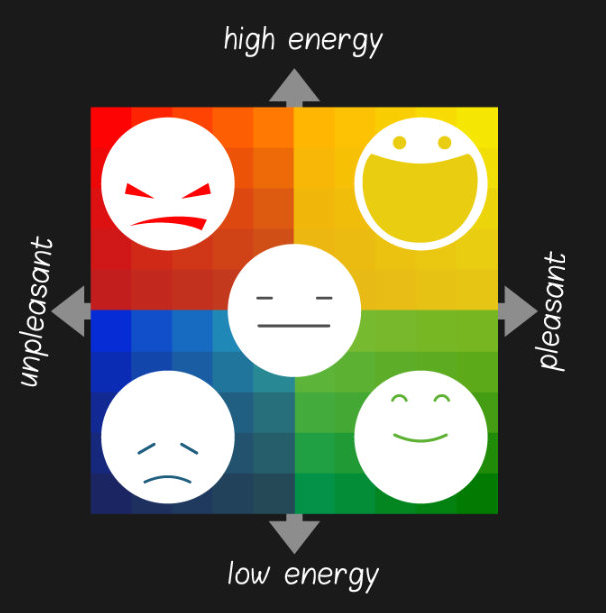 Marc Brackett cares about your feelings – a lot! So much so that this Yale professor and founding director of the Yale Center for Emotional Intelligence has developed an evidence-informed tool for building emotional intelligence through self-awareness and self-regulation[1], that is effective and simple to use for adults and children alike.
Marc Brackett cares about your feelings – a lot! So much so that this Yale professor and founding director of the Yale Center for Emotional Intelligence has developed an evidence-informed tool for building emotional intelligence through self-awareness and self-regulation[1], that is effective and simple to use for adults and children alike.
Enter the Mood Meter, which is an evidence-based road map to your emotions. It is represented by a colourful grid that measures the energy and pleasantness of a feeling, to give you the "coordinates" to your current emotional state. These coordinates locate your emotion in one of 4 Zones, each one representing a group of emotions that have similar levels of energy and pleasantness.
Examples of emotions that belong to each Zone include (image and examples are from the Mood Meter App):

- Yellow Zone (high energy, high pleasantness): pleasant, happy, joyful, hopeful, focused, optimistic, proud, cheerful, lively, playful, excited, thrilled, inspired etc. Links to Heart-Mind quality Alert & Engaged.
- Green Zone (low energy, high pleasantness): at ease, calm, easygoing, secure, grateful, blessed, satisfied, restful, loving, balanced, comfy, cozy, carefree, mellow, thoughtful, serene, etc. Links to Heart-Mind quality Secure & Calm.
- Red Zone (high energy, low pleasantness): peeved, annoyed, irritated, worried, frightened, jittery, tense, troubled, angry, furious, panicked, stressed, anxious, etc.
- Blue Zone (low energy, low pleasantness): apathetic, bored, sad, down, uneasy, miserable, depressed, disheartened, exhausted, hopeless, alienated, despondent, despair, etc.
Just like when you are travelling, when it comes to your emotions it is essential to know where you are in order to chart a route to where you want to go. Locating your emotional state on the Mood Meter gives you a starting point, from which you can tailor your self-care plan (which may include deep breathing, talking to a friend, getting outside, exercise, journalling, etc.) to either stay in the Zone (if you are yellow or green) or shift towards a more desirable one (if you are red or blue).
Marc encourages adults and children to mentally or physically plot their feelings on the Mood-Meter each day. In his own words, doing so “builds the skills of recognizing, labeling, and regulating emotions to live a healthier, more productive, and fulfilling life” – or, simply put, emotional intelligence.[2]
3 Ways to Use the Mood Meter Today!
• Download and use the Mood Meter app available on the App Store and in Google Play
• Make your own personalized mood meter[3]
• Create a life-sized mood meter (classroom/group activity)[4]
The Mood Meter is part of the evidence-informed social-emotional learning system developed by Yale Center for Emotional Intelligence called The RULER Approach.
- Arrange red, yellow, green, and blue construction paper to make a square, and draw and label the axes (alternatively, you can draw it in a notebook or a piece of paper).
- Brainstorm or research emotion words that fit into each Zone – be sure to challenge yourself with some more obscure or sophisticated emotion words to grow your emotional literacy.
- Next, search through newspapers, magazines, online, or even through your own photos to find a photo to match each emotion word.
- Paste these photos onto the grid in the Zone that you think each one belongs to, and label them with their emotion words.
- Optional: Tape the images to the paper on one side only to make a “flap” and hide the emotion word underneath, then play a guessing game with friends, family, or classmates (what emotion does this picture show?)!
- Next time you notice your emotions shift, ask yourself:
- Is this feeling pleasant or unpleasant?
- Is this feeling high energy or low energy?
Based on your answers, plot your feeling on your Mood Meter, and see if any of the emotion words listed describe how you feel. If not, find a word that fits (ask a friend, review a list of emotion words, etc) and add it to your Mood Meter. Over time, your Mood Meter and emotional vocabulary will be sure to grow!
- Make a life-sized grid on the floor using masking tape and large pieces of bulletin board paper in red, yellow, green and blue. Each Zone should be at least 1m x 1m large (or big enough for several people to stand in).
- Assign students emotion words or ask them to pick their own. Invite students to write their word on the front of a piece of paper, and write a definition in their own words on the back. Then ask students to tape their emotion word to their shirt.
- Ask students the following questions:
Is this feeling pleasant or unpleasant?
Is this feeling high energy or low energy? - Based on their answers, invite students to stand in the Zone that their emotion word belongs to (you may need to do this in waves if you have a lot of students)
- One by one, invite students to explain the class why their emotion belongs in that zone. Open the floor for constructive, respectful discussion if there is disagreement about where the emotion word fits.
In a Dutch 2007 study, researchers found that adolescents with higher levels of trait emotional intelligence - defined as _____ - were more likely to use adaptive coping styles such as ____ in the face of stressors, be perceived as co-operative by their peers, and less likely to report depressive thoughts or somatic (body-related) complaints.
Several studies, as reviewed in Brackett, Rivers & Salovey, 2011, have found that higher levels of emotional intelligence, as measured by the Mayer-Salovey-Caruso Emotional Intelligence Test, are:
- negatively correlated with anxiety and depression (David, 2005)
- positively correlated with psychological well-being, attention skills, and likeliness to seek psychological support (eg. psychotherapy) when in need